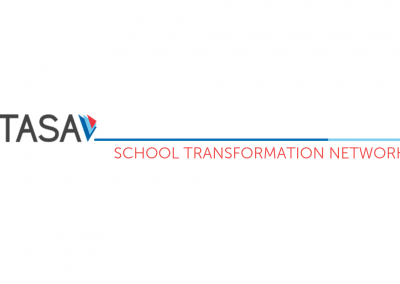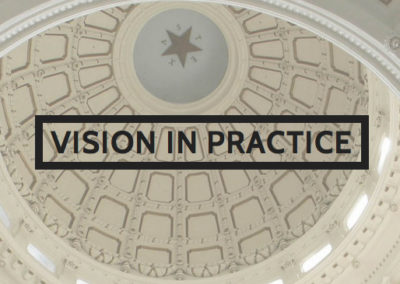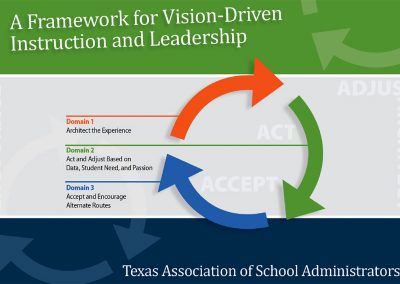To prepare future-ready students, schools must authentically assess student progress using multiple and varied methods that inform educators and parents of the extent to which learning is occurring and that serve as a positive motivator for student success.
Writing samples, project-based learning demos, teacher-developed tests, lab journals, science projects, essays, reading response logs, research papers, rubric assessments, and other student work provide better evidence on a wider range of student knowledge, skills, and progress than do standardized tests.
However, the accountability system for Texas public schools is over-reliant on high-stakes standardized testing, a pressure-inducing situation that lends itself to “teaching to the test” rather than fostering the skills students need to be future-ready.
For assessment to be of value, it must move to a model that resembles a “daily check up,” continuously identifying student strengths, interests, motivations, accomplishments, and other information educators need to design learning experiences that best meet each student’s needs.
The Vision: Multiple Assessments
Using multiple and varied methods of assessment that inform educators and parents of the extent to which learning is occurring is among the principles espoused in the visioning document, Creating a New Vision for Texas Public Education.
Article III: Assessments for Learning
Appropriate and varied types of assessments are essential for informing students about their level of success in ways that affirm and stimulate their efforts and for informing their teachers so that more customized learning experiences may be provided in a timely way. Well-conceived and well-designed assessments should also be used to reveal to parents, the school, the district, and society at large the extent to which the desired learning is occurring and what schools are doing to continuously improve.
Supporting Premises
- Assessments must be framed in a system development approach to meet the information needs of all users of assessment results. The system must be balanced and reflect at least three basic levels of assessment: the classroom level, with particular attention to the impact of the assessment on the learner; the program level, which allows evaluation of program effectiveness; and the institutional level, which appropriately informs policymakers.
- Assessments used by teachers are the most critical for improving instruction and student learning, and to be effective must reflect certain characteristics, be interpreted properly in context, and reported clearly. Conducting good assessments is a part of the art and science of good teaching that results from teacher experiences and formal teacher professional development opportunities.
- Assessment should be used primarily for obtaining student feedback and informing the student and the teacher about the level of student conceptual understanding or skill development so that the teacher has accurate information to consider for designing additional or different learning experiences.
- Assessment should be continuous and comprehensive using multiple tools, rubrics, and processes, and incorporate teacher judgments about student work and performance as well as the judgment of others, when needed.
- Assessment should not be limited to nor even rely substantially on standardized tests that are primarily multiple-choice paper/pencil or on similar online instruments that can be machine-scored.
- Standardized tests should be used primarily to identify hard-to-learn/difficult-to-teach concepts to differentiate learning experiences and focus attention on the more systemic curricular issues involving student performance. Assessments that rely exclusively on quantifiable information remove from the teacher and school informed judgment prerogatives that are necessary to be timely and productive and deny the human aspect of the daily interactions teachers have with students and each other.
- Assessment should reflect and encourage virtual learning and incorporate ways of recognizing its value and counting it as credit in meeting graduation requirements.
- Reports about student performances, generated as a result of assessment, should inform students, parents, the school, and the greater community about how well students are doing.
- Sampling techniques involving all student groups should be employed periodically to evaluate programs and overall student progress. On occasion, community members or other teachers who have particular expertise may observe student performances and participate in protocols gauging the quality of student work products or examinations.
- The voice of students should be respected, and their feedback should be solicited regarding their learning and their response to the tasks they are assigned.
- The voice of teachers should be respected, particularly what they have to say about student performance, curriculum development, and program evaluations.
- The voice of parents should be respected, and they should be involved in feedback processes regarding the response of their children to tasks assigned as well as parental desire to do work at home that extends the learning.
- Assessments for learning, when they are varied and comprehensive, can also furnish important information in context as one factor among many in personnel appraisal systems, in ascertaining the performance levels of campuses and departments, and in measuring the impact of accountability systems on inspiring continuous improvement.
Proposed Strategy
As a strategy for moving forward with the use of multiple assessments to gauge profound learning, the Texas High Performance Schools Consortium (THPSC) districts recommend consideration of short- and long-term strategies.
Short-term Solutions
- Test readiness standards only*
- Include more test items per standard
Long-term Solutions
- Develop/prioritize/coalesce high-quality, fewer, deeper learning standards designed in accord with future-ready learning, college/career readiness, and expectations of the global workplace.
- Establish assessment expectations that rely less on multiple-choice items and more on rigorous, performance tasks.
- Reduce the number of tested grade levels and/or standards.
- Allow for stratified random sampling of students to accommodate the complexity and cost of administering and scoring performance tasks.
- Strengthen training for teachers and staff in best practices associated with building collections of evidence of student learning. This includes, but is not limited to, the use of rubrics, progress portfolios, display portfolios, journals, observation records, and other such methods of learning.
- Work with the Texas Education Agency to establish definitions and standards for collections of evidence of student learning.
- Establish how student work, local assessments, and diagnostic tests are used to identify students in need of additional support.
- Work with TEA and the State Board of Education to develop high-priority learning standards and determine (by grade, subject) which collections of evidence of learning are to be maintained.
- High-priority learning standards and new assessment designs could build the foundation for a new vision of accountability in Texas that aligns with the research on future-ready learning in today’s context and reflects a more balanced local and state partnership, as described in Creating a New Vision for Public Education in Texas.
- High-quality formative assessments are necessary at the classroom and campus level and are our missing component for a balanced assessment system. Policy-makers should ensure resources are available and should provide support for high-quality training in formative assessment.
*Cannot be applied as a long-term strategy due to the progressive, interconnected nature of PK-12 learning standards







